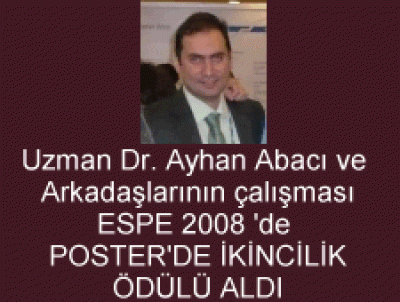Uzman Dr. Ayhan Abacı ve Arkadaşlarının çalışması ESPE 2008de poster bildirilerinde en iyi ikinci bildiri seçildi.

Gülhane Askeri Tıp Akademisinden Uzman Dr. Ayhan Abacı ve arkadaşları"Echocardiographic epicardial adipose tissue in obese children: A new indicator of insulin resistance" başlıklı çalışmaları ile ESPE 2008'de ikincilik ödülü almışlardır. Arkadaşlarımızı tebrik ediyor, başarılarının devamını diliyoruz.
ÖDÜL KAZANAN ÇALIŞMA
Echocardiographic epicardial adipose tissue in obese children: A new indicator of insulin resistance
Ayhan Abaci 1; Emre Tascilar 1; Yilmaz Yozgat 2; Turkay Saritas 2; Ediz Yesilkaya 1; Ayhan Kilic 2; Vedat Okutan 2; M.Koray Lenk 2
1Gulhane Military Medical Academy, Pediatric Endocrinology, Ankara, Turkey; 2Gulhane Military Medical Academy, Pediatric Cardiology, Ankara, Turkey
Aim: Until now, the association between subepicardial fat (SAT), insulin resistance, and intima-media thickness has not been evaluated in obese children. In this study, we evaluated whether echocardiographic SAT is related to insulin resistance, and intima-media thickness in obese children.
Patients - methods: A total of 46 obese patients (10.2 ± 2.46 years of age, 25 male patients) and 30 age- and gender-matched control subjects (10.8 ± 3.11 years of age, 13 male patients) were included in this study. The criterion for diagnosing obesity was defined as the body mass index (BMI) being over 97% percentile of the same gender and age. Serum triglyceride, low- and high-density lipoprotein, cholesterol, and glucose and insulin levels were measured in the fasting state. The estimation of insulin resistance was made using a homeostasis model assessment index. Each subject underwent a transthoracic echocardiogram and the SAT thickness was measured during end-diastole from the parasternal long-axis views.
Results: The obese patients had significantly higher SAT thickness and intima-media thickness values compared to the subjects in the control group (5.7 ± 1.4 vs. 3.02 ± 0.66 mm, 0.78±0.015 vs. 0.05±0.01, p=0.001, respectively). Simple linear regression analysis showed no significant correlation between epicardial adipose tissue and BMI SDS (r=0.08, p= 0.585), insulin resistance(r=0.170, p= 0.264) whereas there was significant correlation between epicardial adipose tissue and intima-media thickness (r=0.379, p=0.02) in obese patients group. In addition intima media thickness was significantly correlated with insulin resistance(r=0.379, p=0.01). As an optimal cut off point, 4.1 mm SAT thickness determined insulin resistance with 90% sensitivity and 61% specificity.
Conclusions: Our study showed that the epicardial fat was significantly related to intima-media thickness. Assessment of SAT(>4.1 mm) and intima-media thickness during routine echocardiographic examination, a non-invasive method, might be used in predicting insulin resistance in obese children easily and reliably.
17-02-2015







